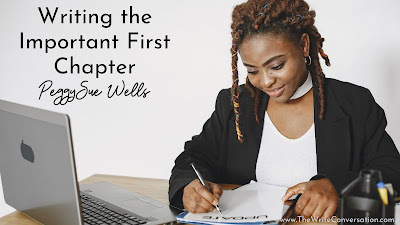Writing the Important First Chapter

by PeggySue Wells @PeggySueWells
The first chapter of a book sells the reader on reading the rest of the book.Your first line prompts the reader to read the first paragraph.The first paragraph compels the reader to read the first chapter.The first chapter invites the reader to finish the book.The last chapter sells your next book.
With so much weight resting on the opening sentence, beginning paragraph, and first chapter, it can be easy for a writer to get high-centered at the onset of a project. In fact, it may be impossible to write the right first chapter at the beginning.
One helpful technique is to put down a good version of chapter one as a start and a place holder. Write messy and get the work underway. After all, you will know more about your fiction for nonfiction when it is finished. Once the rest of the project is written, go back to chapter one and rework this important opening to tailor fit the rest of the manuscript.
Whether fiction or nonfiction, each project develops deeper through the writing process. Fictional characters and plots become multi-layered. A writer often discovers fresh characteristics and motivations about characters that were unknown at the planning stage. In nonfiction, themes emerge and become laser focused.
When the manuscript is complete, you have gained pertinent knowledge of what chapter one can look like. Go back, add foreshadowing, and polish. After Chasing Sunrise was complete, I returned to the early part of the story and added a dive knife to our hero’s scuba gear. Later, when he uses his dive knife, the action was natural because the reader already knew the tool was common to his preparation to travel underwater.
Frequently, once the project is fully written, a writer realizes chapter one is actually not chapter one at all. However, the first writing served well as a launching pad and a place holder so the author could move forward. When Unnatural Causewas complete, it became clear to me and my writers group that my initial chapter one was really chapter two. The final chapter penned in that novel was chapter one.
Writing chapter one as a beginning to the story is logical for the telling. Sometimes this is the right opening. Depending on the genre, a writer may choose to move a key action scene to serve as chapter one. With this format, chapter two takes the reader to the beginning of the tale. The following chapters continue the timeline to reach the pivotal action told in chapter one and carry the reader to the satisfying end.While chapter one is key to your audience reading the book, you don’t have to get it perfect right away. Relax and know revisiting the chapter one when the manuscript is complete will provide what you need to craft an inviting and compelling entry to your book.
TWEETABLEWriting the Important First Chapter from @PeggySueWells on @EdieMelson (Click to Tweet)
 Tropical island votary and history buff, PeggySue Wells parasails, skydives, snorkels, scuba dives, and has taken (but not passed) pilot training. Writing from the 100-Acre Wood in Indiana, Wells is the bestselling author of thirty books including The Slave Across the Street, Slavery in the Land of the Free, Bonding With Your Child Through Boundaries, Homeless for the Holidays, Chasing Sunrise, and The Ten Best Decisions A Single Mom Can Make. Founder of SingleMomCircle.com, PeggySue is named for the Buddy Holly song with the great drumbeat. At school author visits, she teaches students the secrets to writing and speaks at events and conferences. Connect with her at www.PeggySueWells.com, on Facebook at PeggySue Wells, and LinkedIn at linkedin.com/in/peggysuewells
Tropical island votary and history buff, PeggySue Wells parasails, skydives, snorkels, scuba dives, and has taken (but not passed) pilot training. Writing from the 100-Acre Wood in Indiana, Wells is the bestselling author of thirty books including The Slave Across the Street, Slavery in the Land of the Free, Bonding With Your Child Through Boundaries, Homeless for the Holidays, Chasing Sunrise, and The Ten Best Decisions A Single Mom Can Make. Founder of SingleMomCircle.com, PeggySue is named for the Buddy Holly song with the great drumbeat. At school author visits, she teaches students the secrets to writing and speaks at events and conferences. Connect with her at www.PeggySueWells.com, on Facebook at PeggySue Wells, and LinkedIn at linkedin.com/in/peggysuewells
Published on March 04, 2024 22:00
No comments have been added yet.



